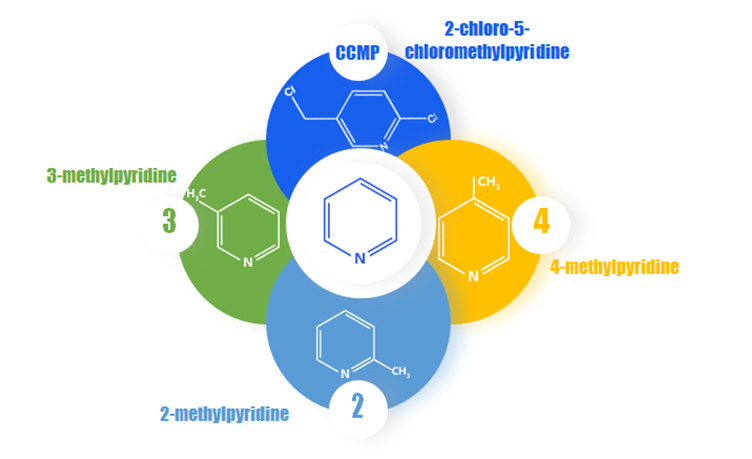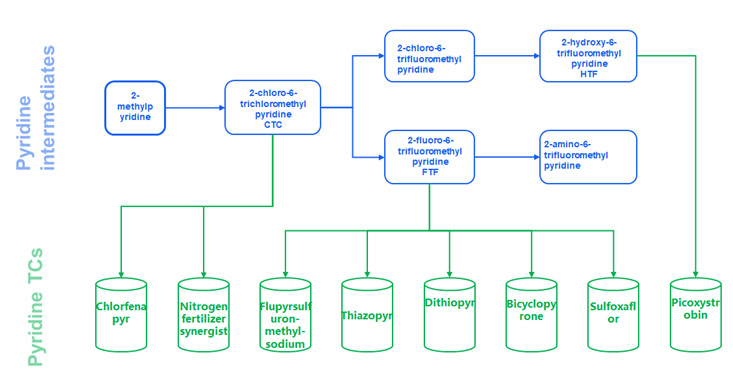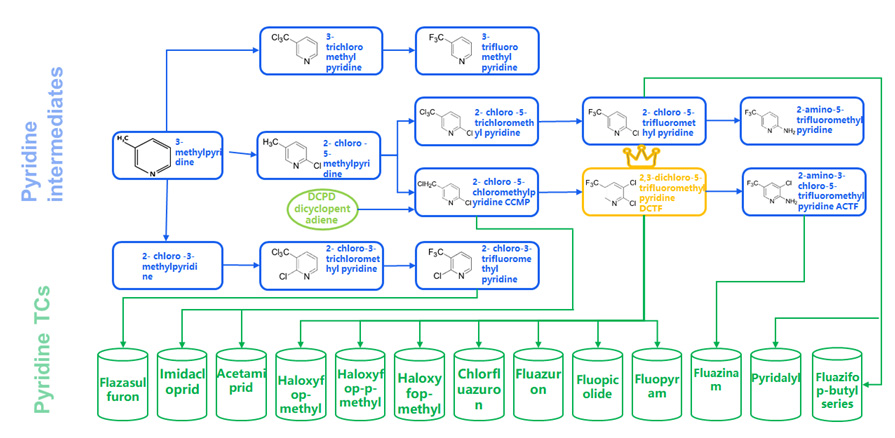Chlorinated and Fluorinated Derivatives of Methylpyridine
We are going to talk about four topics of Chlorinated Methylpyridine and Fluorinated Methylpyridine:
● Classification of methylpyridine and its downstream applications
● Analysis of methylpyridine derivatives' market and supply
● Introduction to pyridine derivatives related products of Huimeng Bio-Tech
● Outlook of agrochemical industry
Pyridine, known as the "chip" of pesticides, medicines and veterinary drugs, is critical intermediate. It is mostly used (up to 50% of the production) in the manufacture and synthesis of pesticides and, based on which, over 30 kinds of products can be produced.
Pesticides containing pyridine moiety are highly efficient with low toxicity and enhanced longevity. They have good environmental compatibility with human beings and organisms, which meet the development requirements and trends of pesticides. Pyridine-containing pesticides are developing rapidly worldwide and are one of the main directions in pesticide innovation.
The whole industrial chain of pyridine compounds shows a tree-like structure, and the pyridine base is the “root” of the entire pyridine industrial chain. Numerous derivatives and end products can be derived from pyridine intermediates to the back end of the industrial chain.
Early on, it was found that more than 20% of the products in the production of pyridine were methylpyridine compounds, mainly the mixture of 3-methylpyridine, 2-methylpyridine and 4-methylpyridine, and 2-chloro-5-chloromethylpyridine (CCMP). To further promote the development of pyridine industry, people started to research and develop these methylpyridine compounds. After years of development and in-depth exploration, methylpyridine derivatives, especially 3-methylpyridine, are now widely used in the agrochemical industry.
Currently, the pesticide industry has evolved to the fourth generation of pesticides. The first generation is organochlorine pesticides, such as DDT and benzex; the second generation is organophosphorus pesticides, such as methamidophos and parathion; the third generation is pyrethroid pesticides, such as cypermethrin and deltamethrin, and the fourth generation is pyridine pesticides such as haloxyfop-P-methyl, fluazifop-P-butyl, fluazifop-P-butyl, fluazinam, fluopyram and picoxystrobin. Methylpyridine derivatives are mainly used to produce the fourth generation of agrochemical products with high efficacy and low toxicity, and most of the intermediates of the fourth generation of advanced pesticides are fluorine-containing pyridine products.
Commonly used methylpyridine products are CCMP (2-chloro-5-chloromethylpyridine), 2-methylpyridine, 3-methylpyridine, and 4-methylpyridine. These four products belong to the category of pyridine, and are the methylpyridine products with the highest application value in the agrochemical industry.

In terms of the production process, there is not necessarily an upstream or downstream relationship between pyridine and various methylpyridine products. Formerly, pyridine was extracted mainly from coal tar, and now it is primarily obtained through the synthesis method. The aldehyde-ammonia method is the most common chemical synthesis method. Different pyridine compounds can be obtained based on raw material aldehyde and different reaction conditions. For example, acetaldehyde reacts with ammonia to produce pyridine, 2-methylpyridine and 4-methylpyridine; acetaldehyde, formaldehyde react with ammonia to produce pyridine, 3-methylpyridine, etc. CCMP can be obtained from the reaction of 3-methylpyridine downward or from the reaction of dicyclopentadiene (as the starting material) with acrylaldehyde or acrylonitrile.
Derivative products of methylpyridine after chlorination and fluorination
There are many derivatives of methylpyridine products after chlorination and fluorination. The specific derivation modes include adding trichloro or trifluoro in 2-6 positions of pyridine moiety; chloro, fluoro, amino, hydroxyl, bromo or iodo to 2 position; chlorio, fluoro, amino or hydroxyl to 2 and 3 positions. The derived products are 2-trifluoromethyl pyridine, 2-chloro-3-trifluoromethyl pyridine, 2-chloro-4-trichloromethyl pyridine, 2-amino-5-trifluoromethyl pyridine, 2-amino-3-chloro-5-trifluoromethyl pyridine, 2-chloro-6-trifluoromethyl pyridine, etc.
The following three figures show in detail the downstream derivatives and applications of each series of 2-methylpyridine, 3-methylpyridine and 4-methylpyridine.
1. Downstream derivatives of 2-methylpyridine

Downstream derivative of 2-methylpyridine (intermediates in blue and pesticide technicals in green)
2-chloro-6-trichloromethyl pyridine (CTC) is obtained by stepwise deep chlorination of 2-methylpyridine. CTC has a wide range of applications. For example, it can be used to produce chlorfenapyr, a pesticide with certain herbicidal activity and can control cyanobacteria in water.
CTC also has a remarkable effect in the field of nitrogen fertilizer synergists. It can inhibit or regulate the nitrification of ammonia nitrogen in the soil or other plant growth media. The consumption of nitrogen fertilizer can be reduced by 30% by adding 1kg of synergist to 1t of nitrogen fertilizer. At present, nitrogen fertilizer synergists have been widely used in developed areas abroad. The product will have a favorable market development prospect, considering its low use rate in the Chinese market.
CTC is subject to further deep fluorination produces 2-fluoro-6-trifluoromethyl pyridine (FTF). FTF is a key intermediate for the production of pesticides flupyrsulfuron-methyl-sodium, thiazopyr, dithiopyr, bicyclopyrone, sulfoxaflor, etc. 2-amino-6-trifluoromethyl pyridine can be produced by introducing ammonia gas to add amino group.
Another process route is to obtain 2-chloro-6-trifluoromethyl pyridine by fluorination of CTC, and then add the hydroxyl by introducing alkali to produce 2-hydroxy-6-trifluoromethyl pyridine (HTF). HTF can be used to produce picoxystrobin.
2. 3-methylpyridine

Comments
Post a Comment